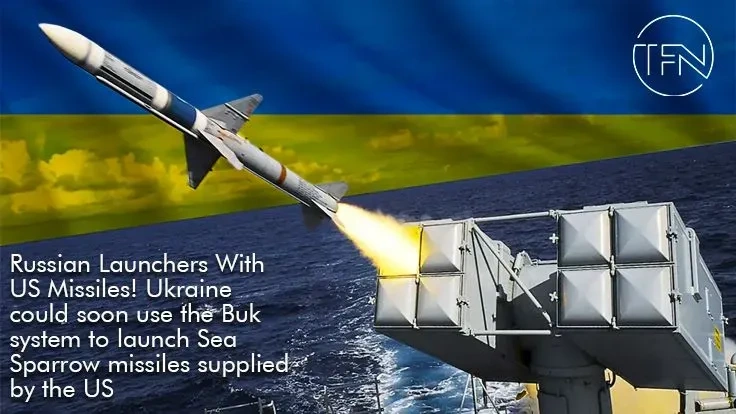
On January 6, the US announced a $3.75 billion weaponry assistance package to strengthen Ukraine's defenses against Russia's ongoing assaults. The deal now includes the US Sea Sparrow air defense missile that Ukraine has been interested in.
The package, which also includes the Bradley Infantry Fighting Vehicle, is intended to aid Ukraine in waging an eastern counteroffensive and defending itself from Russian rockets and kamikaze drones.
"You have no idea how much we adore you, Americans," tweeted the Ukrainian Defense Ministry.
The quantity of RIM-7 Surface-to-Air Missiles sent to Kyiv was kept a secret by the Pentagon. According to Politico, these missiles will be incorporated into the Buk air defense systems from the Soviet period that are currently in use by the Ukrainian Armed Forces (AFU).
The article said that the Ukrainian military has adapted its Buk launchers from the Soviet period to fire the Sea Sparrow, citing two unidentified persons acquainted with the matter. The nature of these adjustments and how they were carried out in the absence of the missile was not further discussed.
Aircraft or cruise missiles may be intercepted by Water Sparrow anti-aircraft missiles, which can be fired from the sea or land. These anti-aircraft missiles will probably assist in reducing Russian missile attacks on Ukrainian cities, which are thought to be part of a Russian strategy to deplete the AFU's air defense.
According to some estimates, the 9M38 missiles launched by the Buk-1 air defense systems during the Soviet period are almost all gone, and the AFU requires missiles to maintain the system operationally. This crucial weakness in Ukraine's armament may have been the driving force for the Sea Sparrow's delivery.
In the later years of the Cold War, tracked self-propelled SAM systems from the Buk series first emerged. In the continuing fight, both sides have widely used several Buk air defense system types.
In a previous assessment, the Royal United Services Institute (RUSI) claimed that the Buk system had destroyed Russian aircraft and stripped them of their air supremacy.
Ironically, Russia has been able to protect itself against Ukrainian fire thanks to the same air defense system. Last year, a Russian general admitted that the Buk missile system was being used to take down MLRS (multiple launch rocket system) rockets launched by AFU.
The terrible downing of flight MH17 over eastern Ukraine in 2014 left the system in the spotlight, but the Sea Sparrow missiles may be the next big thing and a technological breakthrough. It's also possible that this is one of the few times a Soviet system would launch an anti-aircraft missile produced in the West.
Ukrainian Sea Sparrows Are Traveling
The RIM-7 Sea Sparrow has evolved from an initial fast-response point-defense system to an intermediate-range warship armament.
It is a surface-to-air missile that may be launched from land or the water and can stop cruise missiles and airplanes. It can even engage targets that are on the surface under specific circumstances.
It is a short-range, semi-active homing missile (SAHM), which uses radar uplinks to adjust its flight path. Before "illuminating" or "painting" the target with a continuous-wave radar beam to engage, the launch platform, which is often a warship, requires a radar to locate and track the target. Often, an entirely separate radar is used to detect and track the target at first.
The sensitive SARH seeker in the missile's nose, which is tuned to a particular signal from the radar, may be pointed in the direction of the target for the missile's final hit once the target has been locked.
Notably, the 9M38 missile from the Soviet period that the Buk-1 system generally launches is also a semi-active homing missile. The 9M38 weighs 1500 pounds each round compared to the 500 pounds per round of the Sea Sparrow that Ukraine is receiving, making it larger and heavier.
The United States, NATO, and other allies often use it to defend against a variety of air and surface threats, such as fast, low-altitude anti-ship cruise missiles (ASCMs).
The missile's drawbacks include a short-range since it was primarily intended to strike down targets that were flying close to the ships (launch systems). Additionally, the missile may not be able to destroy objects that are flying extremely quickly.
When Ukraine has to fire down as many missiles and drones as possible to keep the power grids functioning, the missile integration will unquestionably keep the air defense system operational. The Sea Sparrow would be a good addition since rumors indicate that Russia expects to deploy additional Shahed-136 suicide drones.
Taiwan is the only nation—outside of Ukraine—that has shown it is capable of launching RIM-7 Sea Sparrow missiles from the ground.
For air defense, Ukraine now uses the S-300 from the Soviet period, NASAMS from the West, and IRIS-T, among other systems. However, it has insisted that stronger air defense capabilities from the West are necessary to counteract Russia's advanced aerial targets, which are virtually invariably intended to destroy vital infrastructure.

